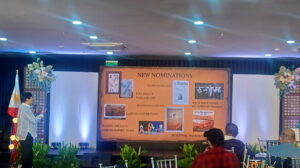IN 2006, the Philippine committee for the United Nations Educational, Scientific, and Cultural Organization’s (UNESCO) Memory of the World Program was formed. Since then, it has helped secure the inscription of many important Filipino documentary treasures, from film collections and traditional music and radio broadcast recordings, to presidential papers and original manuscripts.
At a relaunch of the program’s local arm, the UNESCO National Commission of the Philippines (UNACOM) has renewed its awareness campaign and has called for more leads on historical documents.
Filmmaker, film historian, and UNACOM chair Nick Deocampo told BusinessWorld that, following the Paris headquarters’ opening of nominations back in March (it is held every other year), the Philippine committee is gearing up to prepare nominations and seek out more leads for the coming years.
“The title of the project, Memory of the World, is very poetic. But behind that poetry is the tragic reality where we lose documents almost every day. As we speak, somewhere there’s a photograph or a film that’s decaying,” Mr. Deocampo said at the April 29 press conference in Pasay City.
THIS YEAR’S NOMINEESA culmination of UNACOM’s efforts is the submission of seven nominations this year, in time for the deadline in September.
“We are nominating the Laguna copperplate for the regional (Asia-Pacific) register. It’s an economic transaction from 900 AD, the first extant, well-kept document or record to be found within the country! If that’s not important, I don’t know what is,” Mr. Deocampo said.
An array of forms must be accomplished by the custodian/s and owner/s of a potential inductee, which the committee describes as a “painstaking and even tedious process.” At the end of this, if inscribed, financial support for preservation will be given.
The other nominations include copies of the Spanish-language La Solidaridad newspaper published by the Filipino propaganda movement, and of Jose Rizal’s celebrated novels Noli Me Tángere and El Filibusterismo. There’s also the “Philippine insurgent records,” repatriated from the US in 1957 and now located in the National Library, their nomination facilitated by heritage conservation and tourism educator Ivan Henares.
Mr. Henares, who is also UNACOM’s secretary general, posited that preserving memory “isn’t just the work of historians and archivists.”
“It’s a shared responsibility for anyone who believes our nation’s soul must be remembered, protected, and passed on. Together, we must write a fuller, richer history of the Philippines, one that reflects every voice, every community, and every memory,” he said at the launch.
One example is Pilar Martinez, who has well-kept documents of the Ilonggo community newspaper Makinaugalingon. She brought this up when the committee visited Iloilo for a nomination workshop, leading to its nomination for the Memory of the World this year.
Mr. Deocampo stressed the importance of another nominee, the ethnographic films of Ramon Obusan, who traveled to many tribes and documented them with Super8 film.
“We have forgotten the movements of their hands, the textiles that they used, their practices, their dances. They’re all there, hidden in an Orocan container, not even 500 meters away from the sea,” he lamented. One of the big no-nos of keeping old documents — whether filmed or on paper — is locating them near the ocean, where they are more vulnerable to the elements.
The seventh nomination the committee highlighted were the documents on Filipino comfort women during World War II. “It’s controversial because it’s not a good part of history, but it’s history nonetheless,” Mr. Deocampo said.
LEADS TO PURSUEThe committee shared that community workshops they have held have turned up great results. In Baguio, they got leads on someone claiming they have the oldest Ilocano bible and a family which keeps the Yamashita surrender papers.
However, the UNACOM’s track record has been uneven, according to Mr. Deocampo. “A lot of the documents come from Luzon. We need to have more from Visayas. From Mindanao, we have almost zero,” he said.
Some documents they are pursuing in Mindanao are historically important Muslim writings and Manobo-language recordings.
He shared that the awareness campaign this year will kick off with documentary literacy workshops, which will be held in Naga in July, Dumaguete in August, and Davao in September. There, academics, community members, and archivists can make their nominations.
Relative to other countries, which have up to hundreds of inductees on their registers, the Philippines currently has five in the international category, two in the regional (Asia-Pacific) category, and two in the national category. These are:
International Register
• Palawan Paleographs
• Radio Broadcasts of the People Power Revolution
• Presidential Papers of Manuel L. Quezon
• Musical Collection of José Maceda
Asia-Pacific Register
• Culion Leprosy Archives
• Doctrina Christiana
• “Hinilawod” Epic Chant Recordings
National Register
• The film Ganito Kami Noon, Paano Kayo Ngayon?
• Fernando Poe, Jr. Film Collections
Mr. Deocampo noted that they are “pumped up” to reach out to communities and get leads on where to find more records.
For Mr. Henares, their mission is urgent in a fast-moving digital world where “stories are constantly being retold and sometimes forgotten.”
“We believe it’s time to shine a new light on this important initiative,” he said. “Our records, manuscripts, images, sounds, and stories don’t just recount events. They capture the spirit of who we are. They anchor us to our past and point us toward who we hope to become.” — Brontë H. Lacsamana

